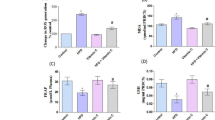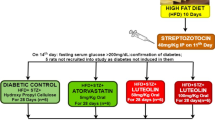Abstract
Effect of aging and hyperglycemia on oxidative stress (OS) and inflammation in dyslipidemic conditions has not been elucidated. Hence, in this study, we assessed the implications of aging, hyperglycemia, and also the dietary effect of n-3 fatty acids (α-linolenic acid (ALA) and eicosapentaenoic acid (EPA) + docosahexaenoic acid (DHA)) on OS and inflammation in dyslipidemic rats. Dyslipidemia was induced in young and aged rats by feeding high-fat lard (HFL) diet. Diabetes was induced in young dyslipidemic rats by administering streptozotocin 30 days after the induction of dyslipidemia. Experimental groups received diets containing canola oil (HF + CNO) and fish oil (HF + FO) as a source of ALA and EPA + DHA respectively. After 60 days of feeding rats with their respective diets, OS and inflammatory markers in serum were assessed. Dyslipidemia caused significant (p < 0.05) increase in OS (lipid peroxidation, nitric oxide, and protein carbonyl), pro-inflammatory cytokine (CRP, IL-1β, MCP-1, and TNF-α), and eicosanoid (PGE2, LTB4, and LTC4) level in serum of both young and aged rats. Aged dyslipidemic rats presented significantly (p < 0.05) higher level of these markers compared to young dyslipidemic rats. Hyperglycemia onset further augmented OS and inflammatory markers in young dyslipidemic rats significantly (p < 0.05). Administration of n-3 fatty acids downregulated the serum markers of OS and inflammation in all the three experimental models. Thus, aging and hyperglycemia onset intensified dyslipidemia-induced OS and inflammation. Dietary preformed EPA + DHA presented larger restorative potentials than precursor ALA in countering OS and inflammation in all the three experimental models.
Similar content being viewed by others
References
Lamharzi, N., C.B. Renard, F. Kramer, S. Pennathur, J.W. Heinecke, A. Chait, and K.E. Bornfeldt. 2004. Hyperlipidemia in concert with hyperglycemia stimulates the proliferation of macrophages in atherosclerotic lesions: potential role of glucose-oxidized LDL. Diabetes 53: 3217–3225.
Neha, J.P., P. Michael, and A.D. Sniderman. 2016. The enigma of glucose and lipid metabolism. JAMA Cardiology 1: 145–146.
Parhofer, K.G. 2015. Interaction between glucose and lipid metabolism: more than diabetic dyslipidemia. Diabetes and Metabolism Journal 39: 353–362.
Harcourt, B.E., S.A. Penfold, and J.M. Forbes. 2013. Coming full circle in diabetes mellitus: from complications to initiation. Nature Reviews Endocrinology 9: 113–123.
Malek, M., R. Aghili, Z. Emami, and M.E. Khamseh. 2013. Risk of cancer in diabetes: the effect of metformin. https://doi.org/10.1155/2013/636927.
Vikram, A., G. Jena, and P. Ramarao. 2010. Insulin-resistance and benign prostatic hyperplasia: the connection. European Journal of Pharmacology 641: 75–81.
Surapon, T. 2015. Oxidative stress, insulin resistance, dyslipidemia and type 2 diabetes mellitus. World Journal of Diabetes 6: 456–480.
Poulose, N., and R. Raju. 2015. Aging and injury: alterations in cellular energetics and organ function. Aging and Disease 5: 101–108.
Morrison, W.R., and L.M. Smith. 1964. Preparation of fatty acid methyl esters and dimethylacetals from lipids with boron fluoride–methanol. Journal of Lipid Research 5: 600–608.
Ohkawa, H., N. Ohishi, and K. Yagi. 1979. Assay for lipid peroxides in animal tissues by thiobarbituric acid reaction. Analytical Biochemistry 95: 351–358.
Green, L.C., D.A. Wagner, J. Glogowski, P.L. Skipper, J.S. Wishnok, and S.R. Tannenbaum. 1982. Analysis of nitrate, nitrite, and [15N] nitrate in biological fluids. Analytical Biochemistry 126: 131–138.
Mesquita, C.S., R. Oliveira, F. Bento, D. Geraldo, J.V. Rodrigues, and J.C. Marcos. 2014. Simplified 2, 4-dinitrophenylhydrazine spectrophotometric assay for quantification of carbonyls in oxidized proteins. Analytical Biochemistry 458: 69–71.
Savji, N., C.B. Rockman, A.H. Skolnick, Y. Guo, M.A. Adelman, T. Riles, and J.S. Berger. 2013. Association between advanced age and vascular disease in different arterial territories: a population database of over 3.6 million subjects. Journal of American College of Cardiology 61: 1736–1743.
Liu, K., M.L. Daviglus, C.M. Loria, L.A. Colangelo, B. Spring, A.C. Moller, and D.M. Lloyd-Jones. 2012. Healthy lifestyle through young adulthood and the presence of low cardiovascular disease risk profile in middle age. Circulation 125: 996–1004.
Yusof, H.M., E.A. Miles, and P. Calder. 2008. Influence of very long-chain n-3 fatty acids on plasma markers of inflammation in middle-aged men. Prostaglandins Leukotrienes Essential Fatty Acids 78: 219–228.
Ramaiyan, B., S. Bettadahalli, and R.R. Talahalli. 2016. Dietary omega-3 but not omega-6 fatty acids down-regulate maternal dyslipidemia induced oxidative stress: a three generation study in rats. Biochemical Biophysical Research Communications 477: 887–894.
Breetha, R., and T.R. Ramaprasad. 2018. Dietary n-3 but not n-6 fatty acids down-regulate maternal dyslipidemia induced inflammation: a three-generation study in rats. Prostaglandins Leukotrienes Essential Fatty Acids 135: 83–91.
Grattagliano, I., V.O. Palmieri, P. Portincasa, A. Moschetta, and G. Palasciano. 2008. Oxidative stress-induced risk factors associated with the metabolic syndrome: a unifying hypothesis. Journal of Nutritional Biochemistry 19: 491–504.
Vasto, S., G. Candore, C.R. Balistreri, M. Caruso, G. Colonna-Romano, M.P. Grimaldi, F. Listi, D. Nuzzo, D. Lio, and C. Caruso. 2007. Inflammatory networks in ageing, age-related diseases and longevity. Mechanisms of Ageing and Development 128: 83–91.
Shodell, M., and F.P. Siegal. 2002. Circulating, interferon-producing plasmacytoid dendritic cells decline during human ageing. Scandinavian Journal of Immunology 56: 518–521.
Franceschi, C., M. Bonafe, S. Valensin, F. Olivieri, M. De Luca, E. Ottaviani, and G. De Benedictis. 2008. Inflammaging: An evolutionary perspective on immunosenescence. Annals of the New York Academy of Sciences 908: 244–254.
Kiecolt-Glaser, J.K., M.A. Belury, R. Andridge, W.B. Malarkey, B.S. Hwang, and R. Glaser. 2012. Omega-3 supplementation lowers inflammation in healthy middle-aged and older adults: a randomized controlled trial. Brain, Behavior and Immunity 26: 988–995.
Penninx, B.W., S.B. Kritchevsky, K. Yaffe, A.B. Newman, E.M. Simonsick, S. Rubin, L. Ferrucci, T. Harris, and M. Pahor. 2003. Inflammatory markers and depressed mood in older persons: results from the health, aging and body composition study. Biological Psychiatry 54: 566–572.
Calder, P.C. 2013. Omega-3 polyunsaturated fatty acids and inflammatory processes: nutrition or pharmacology? British Journal of Clinical Pharmacology 75: 645–662.
Acknowledgments
Ms. Pooja Acharya acknowledges the Council of Scientific and Industrial Research (CSIR), New Delhi, for the award of Senior Research Fellowship.
Funding
This study was funded by 12th 5-year plan project BSC 0404 (Nutri-ARM) from the Council of Scientific and Industrial Research, New Delhi, India.
Author information
Authors and Affiliations
Corresponding author
Ethics declarations
Conflict of Interest
The authors declare that they have no conflict of interest.
Ethical Approval
All the experimental procedures performed in studies involving animals were in accordance with the ethical standards of CSIR-Central Food Technological Research Institute, Mysore, India. The experimental protocols involving animals were approved by the Institutional Animals Care and Use Committee (Approval Number IAEC No.311/14).
Additional information
Publisher’s Note
Springer Nature remains neutral with regard to jurisdictional claims in published maps and institutional affiliations.
Rights and permissions
About this article
Cite this article
Acharya, P., Talahalli, R.R. Aging and Hyperglycemia Intensify Dyslipidemia-Induced Oxidative Stress and Inflammation in Rats: Assessment of Restorative Potentials of ALA and EPA + DHA. Inflammation 42, 946–952 (2019). https://doi.org/10.1007/s10753-018-0949-6
Published:
Issue Date:
DOI: https://doi.org/10.1007/s10753-018-0949-6




